Featured Image: A Common Loon feeds on a young Tiger Trout and Vine Maple in vibrant fall color.
Could it be done? A Diamond Lake boat birding trip and a fall colors drive in one day? The diminishing likelihood of renting a patio boat in late October, and the lure of mid-October fall colors in the mountains led me to try a combined one-day effort in mid-October. Most of my previous boat birding tours on this beautiful 3000-acre lake have been in late October. Mid-October would be a new experience with birds on Diamond Lake and the weather was looking good for fall colors before cold wind and rain stripped the colorful leaves. After putting out invitations to various on-line forums only a few days before the trip, I ended up with four companions: my wife Lisa, Cam, Isabel, and Margi. It was the perfect group for this ambitious adventure!
We met at the Diamond Lake Resort Marina at 07:45 where it was a pleasant 45F. An adult Common Loon transitioning into basic plumage was foraging on fish in the boat basin affording good looks and photos. Most of the time we watched the loon it was “processing” a young Tiger Trout, a sterile hybrid between Brown Trout and Brook Trout introduced to Diamond Lake to keep chub populations in check. Nearby was a flock of about 20 Greater White-fronted Geese, mostly immatures, with a lone Cackling Goose tagging along. Relatively tame Mallards dotted the shoreline and grassy areas. A Canada Jay flew over. Mountain Chickadees called from the trees.






We were provided life jackets, loaded our gear and ourselves onto the 8-person capacity patio boat, and headed off into the wild blue yonder.

As we typically do, we headed generally west, intending to visit the NE corner before heading south along the west side of the lake. Within the first few minutes of travel we spotted two dark birds on the water that turned out to be female Surf Scoters, quite scarce but regular visitors this time of year on the lake.



As it was not long after sunrise, the patchy clouds and backlit Mount Thielsen gave incredible scenery to the trip.


Not long after seeing the scoters, a lone grebe was photographed on the water and flying, later identified from photos as a Horned Grebe. This species is common along the Oregon Coast in fall and winter, but far outnumbered by Eared Grebes on Diamond Lake in fall as we would witness later in the day. A lone California Gull flew by. I wished I had some popcorn.








About 30 minutes after leaving the dock we arrived at the NW corner of the lake near the only large patch of bulrush on the lake. It is not uncommon to see Pied-billed Grebe here and one was waiting for us when we arrived. A small flock of Wood Ducks was also nearby.




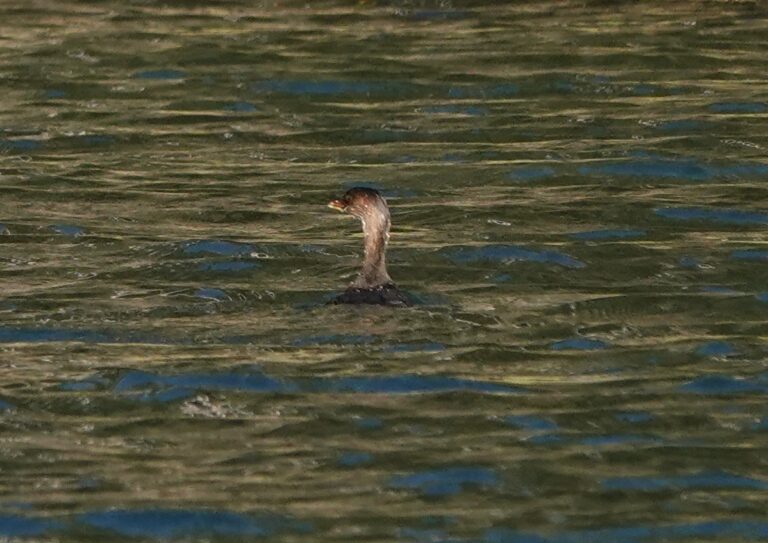
Just north of this bulrush patch are several down trees that have fallen into the water and which have many intact smaller branches. I have found many times that songbirds utilize these trees fallen into the water as perches and access to bathe and drink from the lake. This part of the lake is also somewhat protected from the wind, so it makes for a nice quiet stop for songbirds. Unusual, though not unprecedented, were a couple Townsend Solitaires perched on one of these down trees extending into the lake. They shared the habitat with American Robins and Pine Siskins.





We headed south a couple hundred yards off the west shore of the lake to try to avoid the many submerged logs present there. Another gull or two investigated us. We saw our first Barrow’s Goldeneye and Ring-necked Ducks. A Bald Eagle flew over head. A Spotted Sandpiper danced atop a bleached log. And an Osprey perched on a tall snag, pondering when it would leave for Central America.




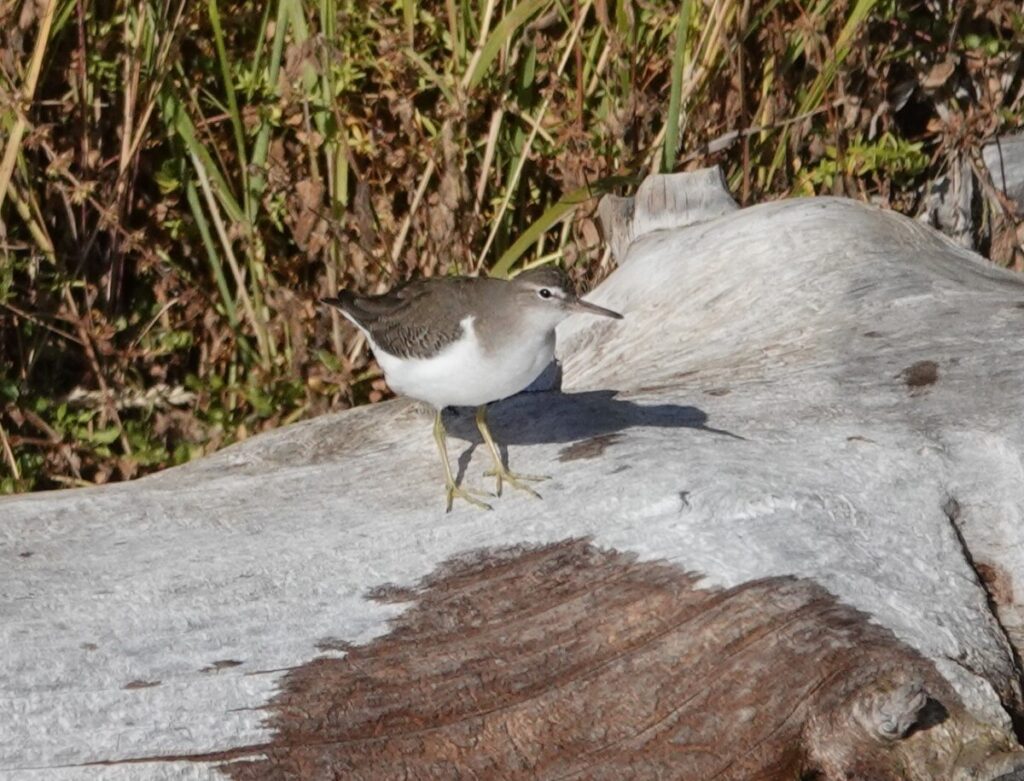


Not many waterfowl were along the west edge of the lake, but as we reached the south end, we began to see where the majority of waterfowl were. Thousands upon thousands of them: American Coots, Bufflehead, Barrow’s Goldeneye, Green-winged Teal, Ruddy Ducks, Ring-necked Ducks, Eared Grebes, Western Grebes, Ring-billed Gull, and two cute Bonaparte’s Gulls. Also present nearby were a few Common Mergansers, Mallards, and American Wigeon. Compared to later in October very few of the Barrow’s Goldeneye were in full basic plumage, but the shape of the adult pattern was visible on several males and color was coming in on the bills of the females.




As we cruised along the south shore, we could hear the cacaphony of an estimated 600 Cackling Geese that temporarily rose up from the South Marsh and settled back down. This was something I had not seen before at South Marsh or anywhere at Diamond Lake. Typically Cackling Geese fly over the area, but I have not seen large flocks land here previously.

After visiting the restroom at the South Shore Day Use Area, we ventured back out into the throngs of waterbirds loafing and foraging at this end of the lake. With the sun behind us we could scan the flocks quite well and for quite some distance because the sun highlighted any pale aspects of plumage. Interestingly, however, when the sun was blocked by clouds, it seemed that 3/4 of the birds had disappeared, the lack of direct sun and somewhat choppy water obscuring many of the birds. We made several passes through the masses, and eventually began to make our way north to return the patio boat in time for our half-day rental.

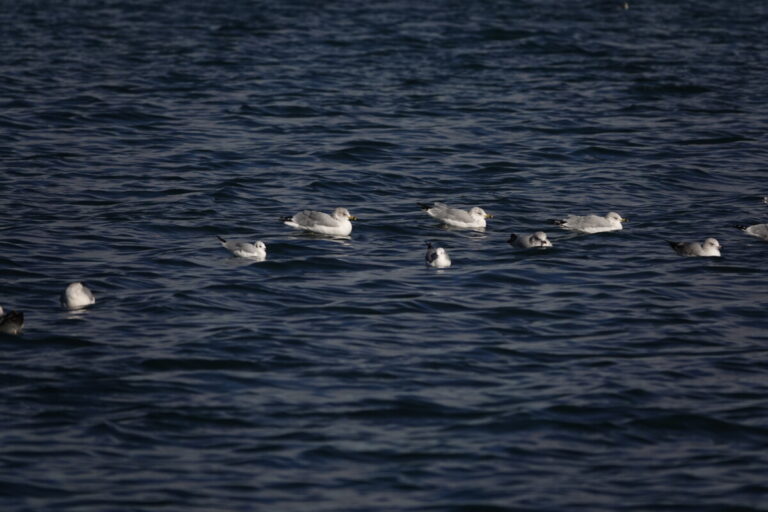





At this time, Eared Grebes seemed to be everywhere; a patch of 12 here, 2 there, 50 there. Another Surf Scoter flushed ahead of us. One Common Loon here, another there. A few scaup were mixed in with the rest of the birds. We would later discover while examining photos two or more Greater Scaup with the Lesser Scaup. We estimated conservatively 800 Eared Grebes for the trip, which is an average number this time of year. As we continued north, we began to glimpse larger flocks of Lesser Scaup in the distance sitting on the water where the Surf Scoters and Horned Grebe were in the morning. These flocks were, as is typical, quite flighty, not allowing close approach and wheeling around in swift rivers of motion. Their message of freedom and powerful grace propelled us to shore on a swell of gratitude for a wonderful half-day spent on Diamond Lake.








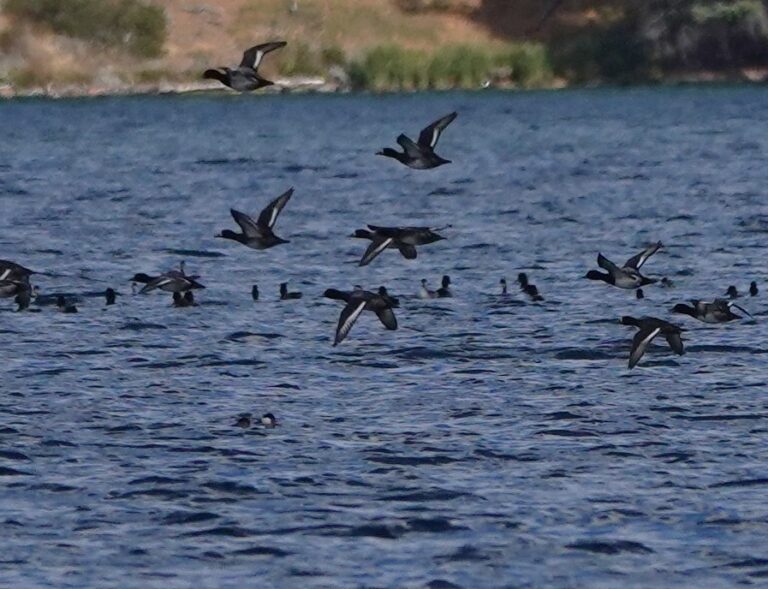




Here is a link to our eBird checklist from the Diamond Lake boat tour, with photos: https://ebird.org/checklist/S198562077. And following is the eBird track of our fun route for the day.

Previous posts and photos from Diamond Lake boat birding trips:
September 17, 2022; October 18, 2015; November 2, 2014.
Fall Colors
We checked in the boat, had a quick bite to eat, used restrooms, and headed west down Highway 138 towards Copeland Creek Road where we would turn south to make our way up to the ridge, the divide between the North and South Umpqua river watersheds. It took about a half-hour to get to Copeland Creek Road and about a half-hour to get to French Junction, our beginning location for the fall colors drive.
We would primarily be traveling north from French Junction, past Mud Lake and up toward Snowbird Mountain, but I had seen a very bright patch of color on recent satellite images (viewed in the Copernicus Browser) just to the south. We parked two cars and loaded into my pickup for a brushy “car-wash” type of ride to the spot of interest. I added dozens of scratches to my well-worn adventure vehicle and nearly flogged those in the back of the pickup with flinging vine maple limbs. I was about to give up, but we finally made it to the site. It was an incredible glow of red and yellow surrounded by green. Below us were innumerable holes of Mountain Beaver (Aplodontia) that required careful navigation to avoid a broken leg.
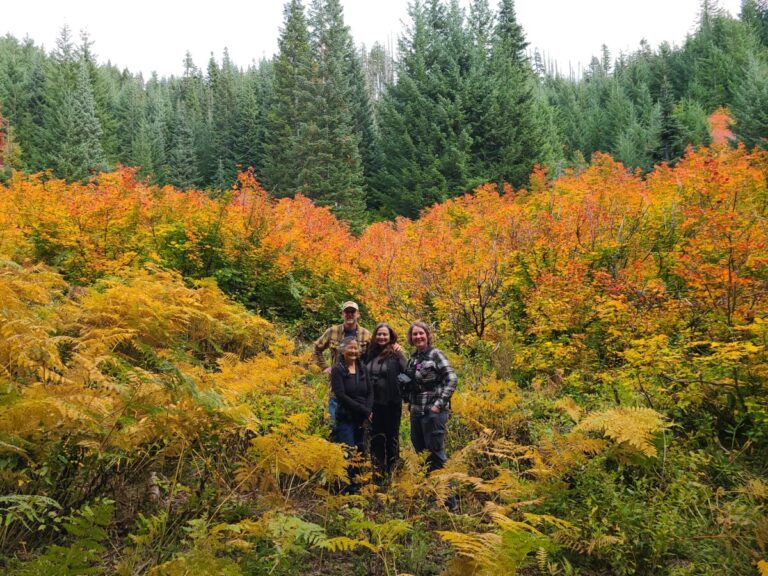



While we were out this little-used road, we stopped a couple places to see what birds were around. We were pleasantly surprised to see Canada Jay, Pacific Wren, Sooty Fox Sparrow, Hermit Thrush, Red-breasted Nuthatch, among others.



After successfully avoiding various dangers encountered during this short offshoot of our main travel route, we reconvened at French Junction where Margi would return home via Copeland Creek Road and Lisa, Cam, Isabel, and I would continue north. By now it was after 3 pm and I wanted to complete our ridge-top travel before 5 pm so we could get back to pavement before dark.
Although the colored patches were not as ubiquitous as I had hoped, and some patches were past prime, some with dried leaves, there were plenty of small patches of color and several patches that were large, diverse, and breathtaking.

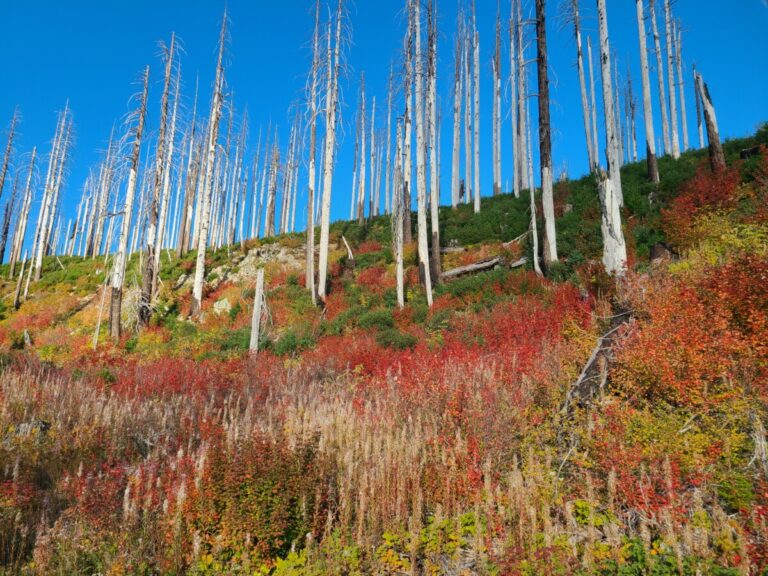




The ridge road was completely gravel, which meant there would be some dust created by driving. In order to share the dust burden, we switched lead cars now and then. At one point Cam and Isabel were ahead. They stopped. As we approached, Cam got out of the car to get our attention. “Is that a Western Meadowlark? I think I just flushed a Western Meadowlark, and now it is up in that huge Douglas-fir snag.” Sure enough, it was a Western Meadowlark. Although they do migrate through in very small numbers, it is quite an unusual sight to see one in a largely forested landscape–although much of this landscape was burned and is now in shrub, snag, and rock habitat.
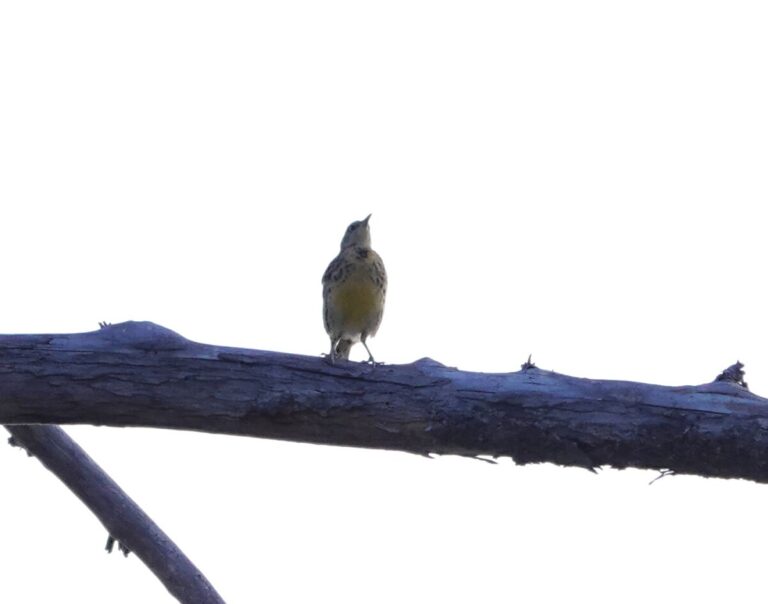







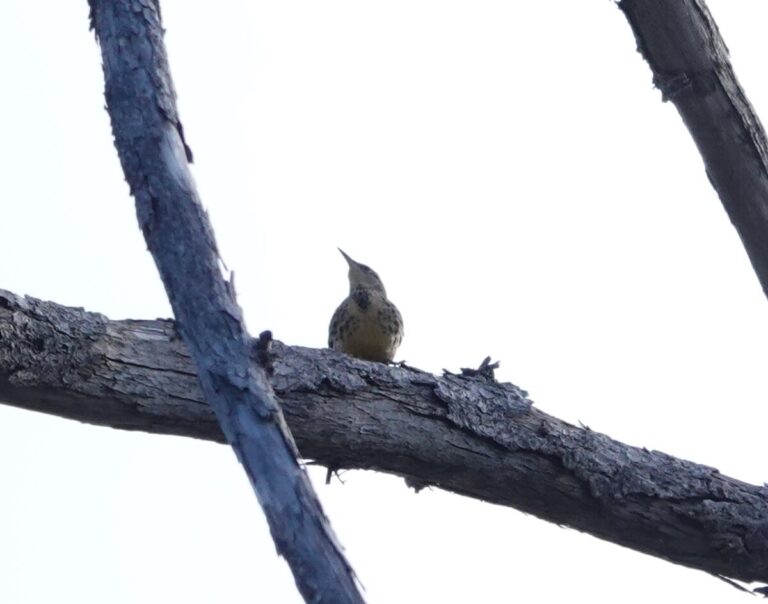
Along this road we were afforded great views of the north side of Quartz Mountain. This unique white-topped feature was mined for high-quality silica and has been for sale.

Farther north along the road were a couple Mountain Bluebirds, also uncommon but present on these high mountain ridges, especially now that the terrain is more open and snags are abundant. I hadn’t really thought about the birding aspect of this fall colors drive. It was fun to see returning species such as (Sooty) Fox Sparrows, Golden-crowned Sparrows, and Ruby-crowned Kinglets. Mountain Bluebirds were exciting, and every couple miles was one or two Red-tailed Hawks plying the late afternoon thermals.
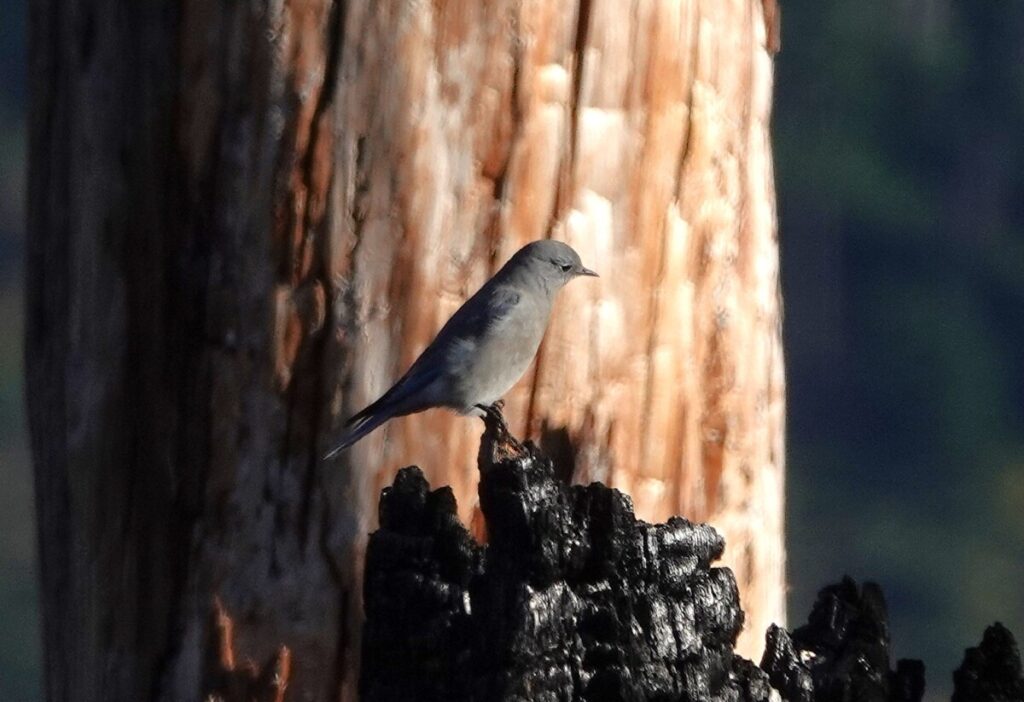
At about 5:30pm it became time to head down the mountain. I decided that instead of going north to Highway 138, which would require more road connections as it got dark, we would go west down to the Little River drainage which would not require much thought in regard to which roads to take. It was all downhill from here as they say. We did stop at Lake-in-the-Woods for a potty stop and were surprised to see a lone immature Greater White-fronted Goose there in the fading light. And the rising moon peeked at us all through the trees.

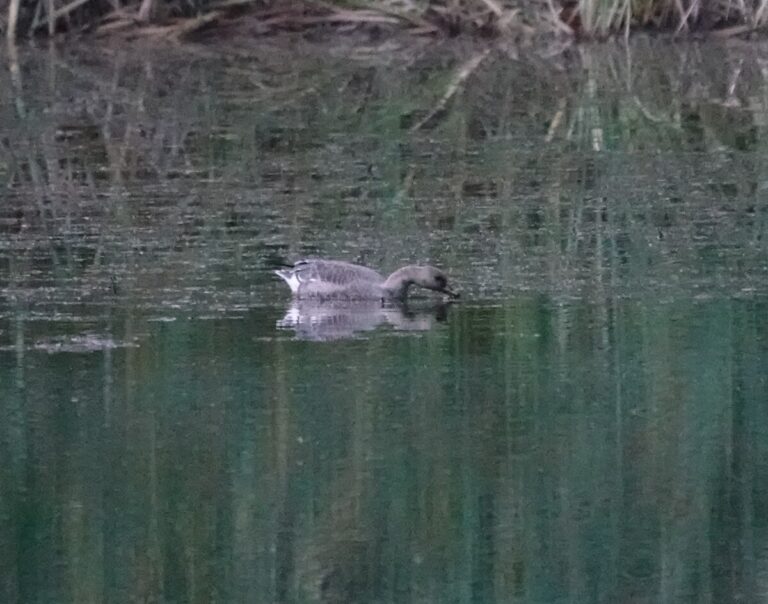
Once on the paved portion of Little River Road, the sun gave us a spectacular end to a big long wonderful day.
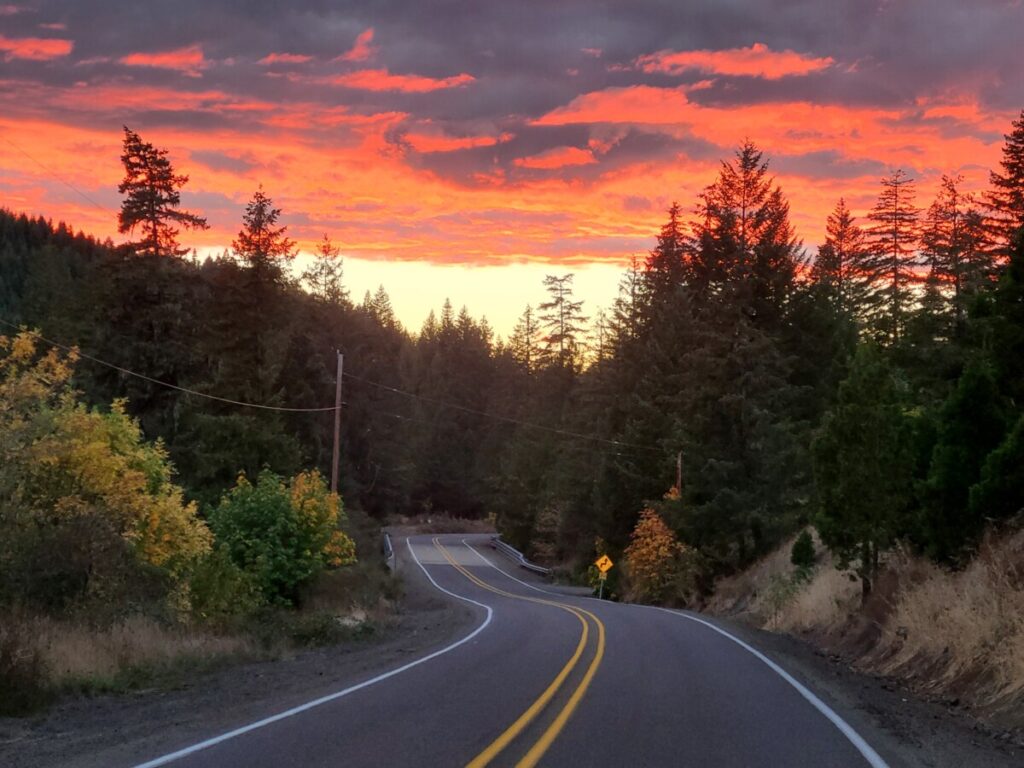
So, was it worth it? Would I do it again? Well, yes and no. It was a wonderful day of spectacular views, experiences, and camaraderie. However, with anyone other than the adventurous souls that joined me, I think it would be too much for one day. I think in the future I would do them separately. I would do the Diamond Lake tours as I have in the past, going into early afternoon rather than ending at 12:30. And, I was pleasantly surprised how birdy the ridges were in mid-October, so the fall colors tour would probably become the Fall Colors and Ridge Birding tour, and could easily start around 10:00 in the morning and go into the afternoon, getting everyone home for dinner with no rush.
We are certainly blessed with wonderfully beautiful lakes and mountains in the Umpqua Basin. Go visit and be refreshed.
Many thanks to my compadre y comadres for their feedback and input on a first draft of this post.

This Post Has 32 Comments
Thanks for a fun illustrated story of a worthy adventure!
You’re welcome David. Good to hear from you! Wish you were closer; it would be fun to have you on one of these enjoyable trips.
Very nice narrative, Matt! Being from Hawaii I am not sure which bird is which but it is amazing to me to see a bird with a fish in its mouth! That bird must be a fast swimmer or have a very swift beak!
The colors are fascinating! We see leaves turning here but they do not show bright colors as yours do!
45F! I would have to wear so much warm clothes that I may not be able to move!
Thank you for sharing, Matt! It makes me want to go regardless of the cold!
Thanks Ken. The blog software has a bug right now that is not allowing my photo labels in the carousels to show, which tell species and other things about each photo. One of these days they will get that fixed!
This is a great way to tour Diamond Lake on a beautiful fall morning and see the birds you photographed. I especially liked the way the birds displayed at the same time I read the narrative about them. Good job picking out a Horned Grebe among 800 Eared Grebes, and a couple of Greater Scaup with all those Lessers. I don’t get to see Bonaparte’s Gulls or Surf Scoters and I didn’t know they were at the lake. Thanks for the colorful and professional presentation. It was nice to see the lake and fall colors – the next best thing to being there.
Thanks Mikeal. Hope you can join us again sometime! 🙂
A pleasure to read your account, Matt. I hope to join you one of these days!
Thanks Jay, I hope you do!!! 🙂
Sounds like a fun day! Thanks for sharing Matt!
You’re welcome, Liz! Come join sometime! 🙂
A Very Ambitious journey!
I enjoyed the beautiful photos and your descriptive musings…thanks!
Mary Anne
Thanks Mary Anne!
Wonderful description and pictures Matt. I wish I had gone. I can agree it’s best to split these 2 adventures into separate days. I love that the brushy colorful area had Mountain Beaver. They are one of my favorite critters. I hope that you keep doing this and offering it to others to join.
Thanks Cindy. Many folks don’t know Mountain Beavers exist so it was fun to point out their burrows. 🙂
Beautifully done Matt. So interesting and informative. Thanks for taking the time and making the effort to share the beautiful Umpqua countrysides with us and including us in your findings along the way. Fantastic!!
Thanks Dad!
I really enjoy your writing. Thank you for including me in the audience . 🥰
Thanks Jeanette! Good to hear from you!
Great report Matt
Thanks Jim!
Thank you for sharing this experience – beautifully done!
Thanks Jack! Come on down next time! 🙂
Wow!!! What a fun and beautiful day you all had! Thanks for the great write up and photos!
Tracy
Thanks Tracy. Hope you can join us sometime. 🙂
Wonderful Matt.
Thank-you Paul!
Very nice.
Thank-you Linda.
Thanks for an excellent post. Lots of good info, very nice narrative and good photos. We used to live in Medford many years ago. Know Diamond Lake well. Never thought of it as a great Fall birding location. Thanks!
Thanks Kirby. It definitely makes a difference to get out on the water!
Hi Matt,
You may not remember me but I was with the group you let on one of the bird walks at our annual OBA meeting at Sutherlin, OR. I really want to thank you for sharing this lovely report of your annual trip. I plan to share it with a 95 year young birder friend of mine who lives in McMinnville. She still enjoys birds and birding but can’t get out very often anymore.’
Thanks again,
Nels PS – I’m only 87. Thankfully, I’m still able to walk 1-3 miles most days while birding and taking photos.
I definitely remember you Nels and appreciate you writing. Good job on the walking! I hope to do that as well!